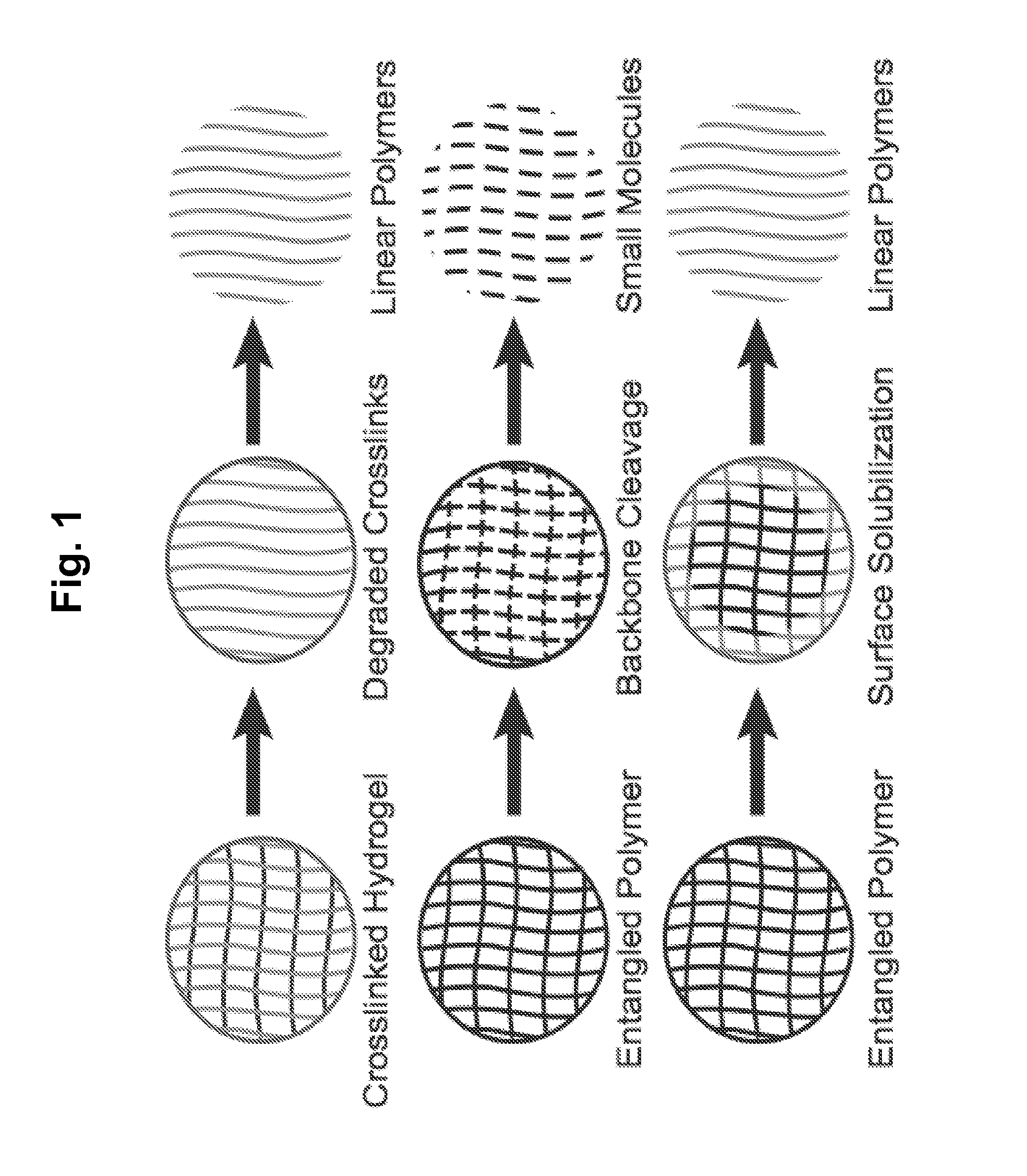Acid-Degradable and Bioerodible Modified Polyhydroxylated Materials
a technology of bioerodible and acid-sensitive materials, applied in the field of acid-degradable and bioerodible materials and polymers, can solve the problems of few easily-prepared polymeric materials that combine acid-sensitivity and biodegradability
- Summary
- Abstract
- Description
- Claims
- Application Information
AI Technical Summary
Benefits of technology
Problems solved by technology
Method used
Image
Examples
example 1
Synthesis and Characterization of Acid-Degradable Acetal-Derivatized Dextran
We sought to create a system with the flexibility and biocompatibility of polyester materials, but with the additional benefit of a change in rate of payload release that is sensitive to physiologically relevant acidic conditions. We discovered a solubility switching mechanism in which a biocompatible, water-soluble polymer could be reversibly modified to make it insoluble in water, but soluble in organic solvents. Materials made from the modified polymer could then be degraded under the specific conditions that reverse the original modification. Dextran, a bacterially derived homopolysaccharide of glucose, was chosen to be modified because of its biocompatibility, biodegradability, wide availability, and ease of modification ((a) Hermanson, G. T., Bioconjugate Techniques. Academic Press: San Diego, 1996 (b) Naessens, M.; Cerdobbel, A.; Soetaert, W.; Vandamme, E. J., J. Chem. Technol. Biotechnol. 2005, 80, 8...
example 2
Materials and Methods for the Examples
General Procedures and Materials. All reagents were purchased from commercial sources and used without further purification unless otherwise specified. Water (dd-H2O) for buffers and particle washing steps was purified to a resistance of 18 MΩ using a NANOpure purification system (Barnstead, USA). When used in the presence of acetal containing materials, dd-H2O was rendered basic (pH 8) by the addition of triethylamine (TEA) (approximately 0.01%). 1H NMR spectra were recorded at 400 MHz and 13C spectra were recorded at 100 MHz. To prevent acid catalyzed hydrolysis of acetal containing compounds, CDCl3 was passed through a plug of basic alumina prior to recording NMR spectra. Multiangle light scattering (MALS) experiments were performed with a Waters 510 pump, a 7125 Rheodyne injector, a Wyatt Optilab differential refractive index detector and a Wyatt DAWN-EOS MALS detector. Absolute molecular weights determined from light scattering data were ca...
example 3
The Acetalation of Water-Soluble Polyhydroxylated Polymers Resulting in pH-Sensitive Hydrophobic Polymers: Examples of Modification of Polyhydroxylated Polymers
Synthesis of Acetalated Dextran (Dimethyl Acetal Dextran: Ac-DEX). A flame-dried flask was charged with dextran (Mw=10 500 g / mol, 1.00 g, 0.095 mmol) and purged with dry N2. Anhydrous DMSO (10 mL) was added and the resulting mixture was stirred until complete dissolution of the dextran was observed. Pyridiniump-toluenesulfonate (15.6 mg, 0.062 mmol) was added followed by 2-methoxypropene (3.4 mL, 37 mmol). The flask was placed under a positive pressure of N2, then sealed to prevent evaporation of 2-methoxypropene. After 6 h, the reaction was quenched with TEA (1 mL, 7 mmol) and the modified dextran was precipitated in dd-H2O (100 mL). The product was isolated by centrifugation at 4 600×g for 10 min and the resulting pellet was washed thoroughly with dd-H2O (2×50 mL, pH 8) by vortexing and sonication followed by centrifugation...
PUM
| Property | Measurement | Unit |
|---|---|---|
| Fraction | aaaaa | aaaaa |
| Fraction | aaaaa | aaaaa |
| Fraction | aaaaa | aaaaa |
Abstract
Description
Claims
Application Information
 Login to View More
Login to View More - R&D
- Intellectual Property
- Life Sciences
- Materials
- Tech Scout
- Unparalleled Data Quality
- Higher Quality Content
- 60% Fewer Hallucinations
Browse by: Latest US Patents, China's latest patents, Technical Efficacy Thesaurus, Application Domain, Technology Topic, Popular Technical Reports.
© 2025 PatSnap. All rights reserved.Legal|Privacy policy|Modern Slavery Act Transparency Statement|Sitemap|About US| Contact US: help@patsnap.com



